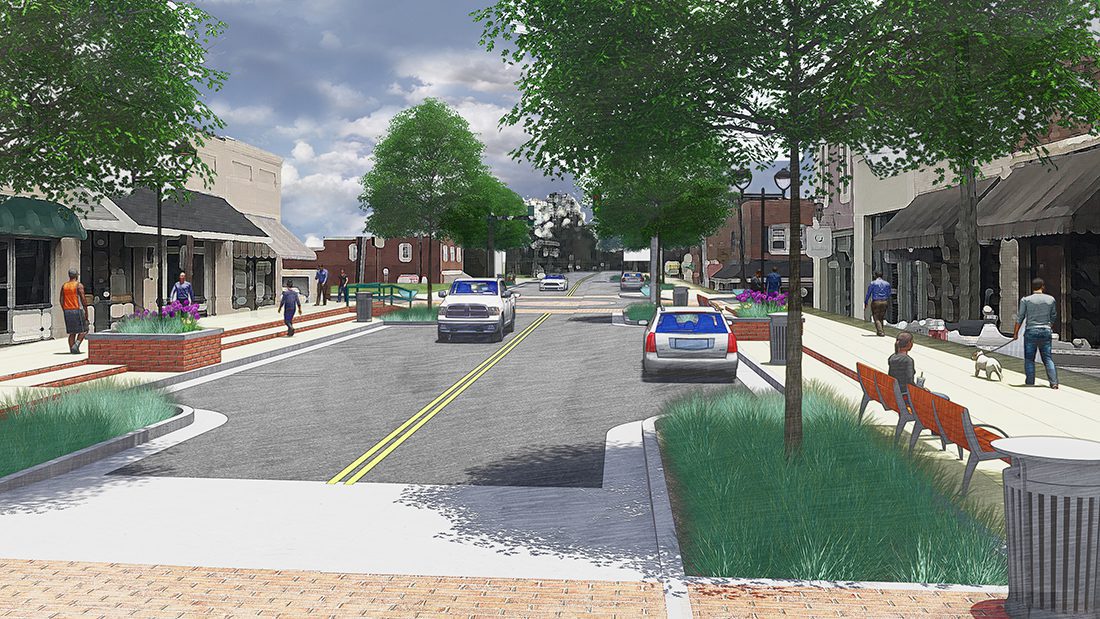
Landscape Architects and Urban Planners are helping create pedestrian-friendly streetscapes that balance the needs of pedestrians, cyclists, and motorists. These improved streetscapes protect travelers, enhance communities, and drive economic development.
Fayetteville Street in Raleigh is a primary example. For 30 years, the street was closed to motor vehicles. The downtown thoroughfare acted as a pedestrian mall until 2006, when it reopened to vehicle traffic amidst much celebration. Both eras reflect the idea that downtown areas exist in a binary: they either allow or prohibit cars.
Today, downtown areas are evolving into a place where pedestrians, cyclists, and motorists can happily coexist as they travel and recreate. Streetscapes are a key part of bringing about this change.
A well-designed streetscape addresses four major concerns: safety, aesthetics, cultural identity, and critical infrastructure. Thinking carefully about where and how these elements intersect in a specific project opens pathways for maximizing their benefits.
A streetscape designed for safety provides everyone the ability to see and navigate their surroundings. A savvy design avoids blind corners and accidental hiding places, provides adequate lighting, and uses signage to clearly direct visitors. Designated bicycle lanes and landscape buffers between road traffic and sidewalks can also increase safety.
In the Town of Burgaw, for example, WithersRavenel proposed a shared street concept where sidewalks and vehicular travel lanes were at the same elevation. Special paving, street trees, and planters along Courthouse Avenue create a safe place for motorists, pedestrians, and other visitors. The plantings provide shade to reduce heat island effects, and the porous paving reduces stormwater loads on existing infrastructure. These stormwater benefits are also on display at the Greensboro Downtown Greenway, part of a sustainable stormwater system.
Aesthetic considerations include getting to know the local history, ordinances around sign styles and building facades, and context-sensitive choices for construction materials. When making recommendations, WithersRavenel considers such factors as expected traffic volumes, operations and maintenance capabilities, the availability of local materials, and community branding.
For the Town of Four Oaks Downtown Streetscape Master Plan, our planners suggested shifting the curb lines to expand sidewalk areas and coordinating paver types to be used in the sidewalks and crosswalks. Street trees were proposed to help with shade and screen overhead electric lines. An oak leaf motif was also incorporated into the main intersection, a common example of the overlap between aesthetics and cultural identity.
Gary Warner, Dan Greenberg, Zack Grossl, Shelbe West, and Rifat Sharmin collaborate during the design of phase 2 of the Four Oaks Downtown Streetscape.
Cultural identity encompasses the past, present, and future through storytelling and public art. Uncovering and reflecting a community’s identity is a collaborative process that first and foremost involves talking to residents and local stakeholders to capture their stories and capitalize on their unique perspectives. It also includes researching historical texts, maps, and photographs.
Armed with this historical information, we consult the community with precedent images to find out their tastes for showcasing its identity. The results are woven into the streetscape design via murals, sculptures, and interpretive signage, as well as figural or abstract imagery used on benches, trash cans, retaining walls, and light poles.
In Whiteville, the historical identity of the downtown area has been one of railroad activity and small business success stories,” noted Sean Martin, former Economic Development Planner at the City of Whiteville and current Town Administrator of the Town of White Lake. “Through the streetscape project, downtown Whiteville is able to highlight the historical cultural identity of the area while providing improvements to the area to recreate the downtown square once observed as Vineland Station.”
Finally, streetscapes incorporate critical infrastructure, which offer opportunities for sustainable design. Stormwater control measures, for instance, may incorporate green infrastructure principles. Because half of downtown Whiteville is in a floodplain, WithersRavenel proposed streetscape infrastructure to help alleviate recurring flooding. Other sustainable solutions include solar-powered lighting, reclaimed materials, cool roofs and cool pavements, and accommodations for public transit and cyclists.
Harmonizing safety, aesthetics, cultural identity, and critical infrastructure make streetscapes that feel safe and welcoming to pedestrians, cyclists, and motorists. They encourage visitors to park farther away or ditch their cars entirely and explore downtown on foot. This leads to more traffic at shops, restaurants, and galleries. For this reason, streetscapes are excellent economic drivers.
Mr. Martin agrees: “An enjoyable walk downtown invites the public to shop local, observe the natural beauty of the area, and make a new friend or catch up with a neighbor. The economic impact of the [Whiteville] streetscape plan is evident as the revitalization continues in the downtown area through the addition, retention, and expansion of small business and mixed-use residential projects.”
Because streetscapes incorporate form as well as function and rely heavily on stakeholder involvement, they can also act as vehicles to gain support for less exciting projects like utility replacements. It can be challenging to secure community buy-in for replacing aging water or sewer lines on a busy street; it is a lot easier to fold a utility replacement or upgrade into a streetscape project where that same road disturbance will become an attractive downtown promenade.
The biggest hurdle to creating streetscapes is often the large price tag. This is often overcome by planning a streetscape project to be completed in phases over multiple years as funding becomes available. Fortunately, this puts municipalities in a position to partner with other agencies, including the NCDOT and funding sources such as the U.S. Department of Housing and Urban Development, U.S. Department of Agriculture, and North Carolina Department of Commerce.
WithersRavenel has planners, landscape architects, and funding specialists to take your pedestrian-friendly streetscapes from concepts to concrete. By working collaboratively with municipalities, citizens, and other stakeholders, they create urban environments that strike a balance between the built and natural landscape while encouraging businesses and communities to flourish.
For questions, contact:
- Planning – Gary Warner at (919) 535-5238 or gwarner@withersravenel.com
- Landscape Architecture – Kurt Pfeifer at (919) 535-5144 or kpfeifer@withersravenel.com
- Funding – Amanda Whitaker at awhitaker@withersravenel.com
